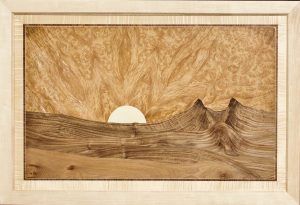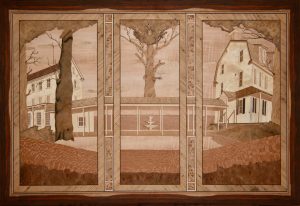Deadline Approaching: Artist Opportunity Grants (January 2) >>> More Info


By: Gail Obenreder
“I have affection for all wood species and the character of their fascia or grain. Wood is such a generous medium.”
Over the course of thirty-five years, Robert Bruce Weston carved out a major career in architectural woodcraft as an in-demand design/build cabinetmaker. He worked with architects and designers in the New York metropolitan area, as well as built a client base for major furniture commissions. Entering the field in his thirties “as an experiment to learn if I liked working with my hands,” Weston apprenticed with master furniture designer Robert G. Huyler to develop his skills and style, ultimately opening his own 20-person 18,000-square-foot shop.


Over the course of this lifetime of work, Weston became enamored with exotic and domestic woods, and he amassed a prodigious inventory (thousands of square feet) of their veneers. When a New Jersey client commissioned him to do a “Monet-like wall hanging using wood veneers,” his practice as an artist painting with wood was born.
Two major sources inspire Weston’s artworks. Sometimes, he utilizes his own photographic images, and the Milton resident “rarely leaves my house without a camera to capture the beauty of Southern Delaware.” But many times his subject is closer at hand, “discovered within the grain pattern of a piece of wood, similar to . . . discovering an image in cloud formations.” As he works, the artist often enhances his creations with oil pastels, ink, or dyes.


Weston grew up in a multi-generational household – “a blue-collar family in a blue-collar Northern New Jersey town” – and much of his career was spent in that region. But in 2008 (soon after he retired and closed his shop) the artist and his wife moved to Sussex County.
Carving out a place in the art world and finding his market have been Weston’s major artistic challenges. “People tended to see the work as craft rather than fine art,” so it was difficult to find art exhibitions where his pieces were accepted. But he now shows in at least three exhibitions each year. An “instinctive designer,” Weston finds his biggest reward in “the process of cutting and discovering,” and raw-state works often hang in his studio as he waits “for the next step to become obvious.”
Weston plans to use his award funds to replace or update aging equipment and purchase hitherto unaffordable exotic veneers that will allow him to explore a technique with multiple layers of wood that is inspired by Japanese lacquer carving. Honored by receiving a Division Fellowship, Weston also feels that the award will open up new opportunities and artistic horizons.
Fellowship Home